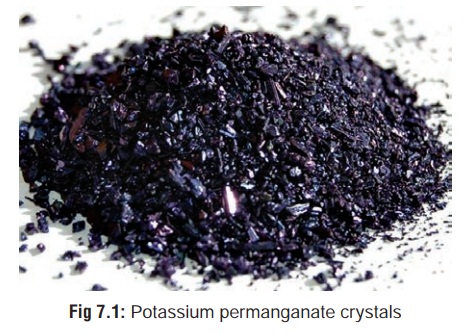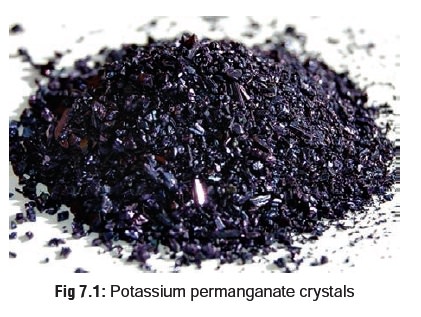Chapter: Modern Medical Toxicology: Corrosive(Caustic) Poisons: Alkalis and Other Caustics
Potassium Permanganate - Corrosive(Caustic) Poisons

OTHER CAUSTICS
Potassium Permanganate
Synonyms
Condy’s
crystals; Chameleon mineral; Purple salt.
![]()
Physical Appearance
At
room temperature, potassium permanganate exists as dark purple or
bronze-coloured, odourless, sweetish, astringent orthorhombic crystals (Fig 7.1) that are almost opaque by
transmitted light and have a blue, metallic sheen by reflected light. On
contact with water it produces potassium hydroxide which probably accounts for
its corrosive effects. Oxygen and manganese dioxide are also generated on
contact with water.

Uses
·
Potassium permanganate’s industrial
uses include bleaching resins, waxes, fats, oils, cotton, silk and other
fibres; dyeing wood; printing fabrics; purifying air and water; etching rubber
and plastic; and tanning leathers. It is also used as a fungicide; insecticide;
miticide; algicide; bacteriocide; germicide; antiseptic; oxidiser;
disinfectant; deodorant; sanitiser; chemical in photography; and reagent in
analytical and synthetic organic chemistry.
·
Therapeutically, potassium
permanganate is used as a topical anti-infective. In veterinary medicine it is
used as a topical antiseptic, astringent, and deodorant.
·
Illicit uses have included the
production of drugs of abuse, and as an abortifacient by topical application to
the vaginal wall.
Usual Fatal Dose
About
5 to 10 grams.
Mode of Action
In
concentrations exceeding 1:5000 (as a solution), potassium permanganate is an
irritant, and in highly concentrated form it acts as a corrosive. It also
exhibits systemic toxicity.
Clinical Features
· Intense burning pain with difficulty
in swallowing, abdom-inal pain, vomiting, and diarrhoea. There is usually
severe thirst. Vomitus may be purple brown in colour. Stools are often black
due to manganese sulfide.
· Skin and mucosa are usually stained
deep brown or black due to manganese dioxide.
·
If potassium permanganate comes in contact with air
passages, it can provoke severe inflammatory oedema leading to dyspnoea and
stridor.
· Complications: shock, hepatic and
renal failure, acute haemorrhagic pancreatitis, and methaemoglobinaemia, which
manifests as dyspnoea, headache, fatigue, CNS depression, tachycardia,
acidosis, etc.
· Use as an abortifacient may result
in vaginal or cervical burns and erosions, with extensive bleeding, shock,
severe scarring and miscarriage as possible complications.
·
Chronic ingestion of potassium permanganate may result in
manganese poisoning.
Diagnosis
Permanganate
stains are decolourised by oxalic acid plus a trace of sulfuric acid, or by
hydrogen peroxide.
Serum
and urine manganese levels are often elevated after exposure, but their
prognostic value is not clear.
Treatment
· Immediate dilution with water or
milk may help. Gastric lavage is best avoided. However, if corrosion is not
severe, it can be done with dilute hydrogen peroxide (10 ml of 3% solution in
100 ml of water).
· Treatment of methaemoglobinaemia
with methylene blue: 1 to 2 mg/kg/dose (0.1 to 0.2 ml/kg/dose) intravenously
over 5 minutes as needed every 4 hours.
· Chelation with EDTA and sodium
para-aminosalicylic acid has been used in patients with manganese
intoxi-cation. While there is no experience with potassium permanganate
exposure, chelation might be considered in patients with neurologic effects
after chronic or subacute intoxication.
· Supportive measures.
Autopsy Features
·
Brownish black staining of tissues.
·
Corrosion of oesophagus and stomach.
·
Evidence of hepatic and renal
damage.
·
Congestion of airways; pulmonary
oedema.
Forensic Issues
·
Accidental poisoning occurs in the
following ways
o Children
swallowing the attractive looking crystals, mistaking them for sweets, or out
of plain curiosity.
o Therapeutic misuse: Potassium
permanganate was formerly used as treatment for amenorrhoea, as an
abortifacient, as a gastric lavage solution, and as an irrigant of the urethra
and bladder in the treatment of gonorrhoea.
o Industrial
exposure.
·
Suicidal ingestions have been
reported from time to time.
Related Topics